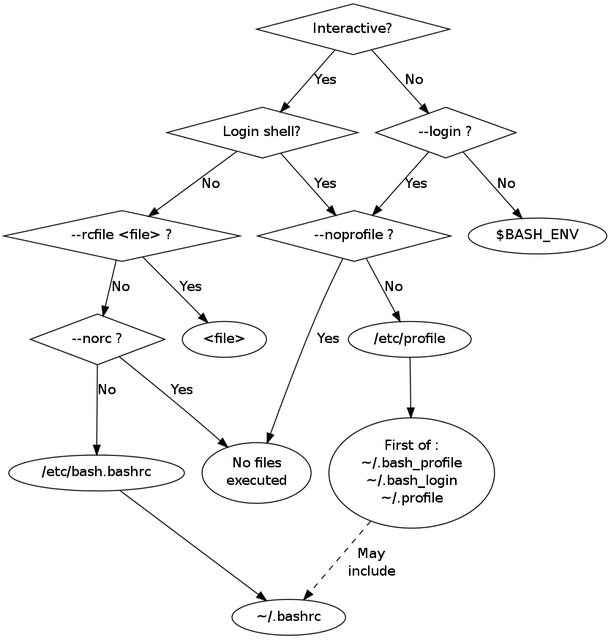运行sudo命令时,有时会提示:
1 2 [qisheng.li@yd_app_api_02 ~]$ sudo -u tomcat jstack 123 sudo: jstack: command not found
但是查看/etc/profile可以看到:
1 2 3 export JAVA_HOME=/usr/local /jdk/defaultexport PATH=$JAVA_HOME /bin:$PATH export CLASSPATH=.:$JAVA_HOME /lib/dt.jar:$JAVA_HOME /lib/tools.jar
确实导出了环境变量,那么为什么运行的时候不成功呢?
换成如下的命令,可以找到:
1 2 [qisheng.li@yd_app_api_02 ~]$ sudo -i -u tomcat jstack 123 123: No such process
这次成功的找到了命令,区别在哪儿?
可以通过下面的命令查看环境变量:
1 2 3 4 5 6 7 8 9 10 11 12 13 14 15 16 17 18 19 20 21 22 23 24 [qisheng.li@yd_app_api_02 ~]$ sudo -i -u tomcat env HOSTNAME=yd_app_api_02 SHELL=/bin/bash TERM=xterm-256color HISTSIZE=1000 USER=tomcat LS_COLORS=rs=0:di=38;5;27:ln=38;5;51:mh=44;38;5;15:pi=40;38;5;11:so=38;5;13:do =38;5;5:bd=48;5;232;38;5;11:cd =48;5;232;38;5;3:or=48;5;232;38;5;9:mi=05;48;5;232;38;5;15:su=48;5;196;38;5;15:sg=48;5;11;38;5;16:ca=48;5;196;38;5;226:tw=48;5;10;38;5;16:ow=48;5;10;38;5;21:st=48;5;21;38;5;15:ex=38;5;34:*.tar=38;5;9:*.tgz=38;5;9:*.arc=38;5;9:*.arj=38;5;9:*.taz=38;5;9:*.lha=38;5;9:*.lz4=38;5;9:*.lzh=38;5;9:*.lzma=38;5;9:*.tlz=38;5;9:*.txz=38;5;9:*.tzo=38;5;9:*.t7z=38;5;9:*.zip=38;5;9:*.z=38;5;9:*.Z=38;5;9:*.dz=38;5;9:*.gz=38;5;9:*.lrz=38;5;9:*.lz=38;5;9:*.lzo=38;5;9:*.xz=38;5;9:*.bz2=38;5;9:*.bz=38;5;9:*.tbz=38;5;9:*.tbz2=38;5;9:*.tz=38;5;9:*.deb=38;5;9:*.rpm=38;5;9:*.jar=38;5;9:*.war=38;5;9:*.ear=38;5;9:*.sar=38;5;9:*.rar=38;5;9:*.alz=38;5;9:*.ace=38;5;9:*.zoo=38;5;9:*.cpio=38;5;9:*.7z=38;5;9:*.rz=38;5;9:*.cab=38;5;9:*.jpg=38;5;13:*.jpeg=38;5;13:*.gif=38;5;13:*.bmp=38;5;13:*.pbm=38;5;13:*.pgm=38;5;13:*.ppm=38;5;13:*.tga=38;5;13:*.xbm=38;5;13:*.xpm=38;5;13:*.tif=38;5;13:*.tiff=38;5;13:*.png=38;5;13:*.svg=38;5;13:*.svgz=38;5;13:*.mng=38;5;13:*.pcx=38;5;13:*.mov=38;5;13:*.mpg=38;5;13:*.mpeg=38;5;13:*.m2v=38;5;13:*.mkv=38;5;13:*.webm=38;5;13:*.ogm=38;5;13:*.mp4=38;5;13:*.m4v=38;5;13:*.mp4v=38;5;13:*.vob=38;5;13:*.qt=38;5;13:*.nuv=38;5;13:*.wmv=38;5;13:*.asf=38;5;13:*.rm=38;5;13:*.rmvb=38;5;13:*.flc=38;5;13:*.avi=38;5;13:*.fli=38;5;13:*.flv=38;5;13:*.gl=38;5;13:*.dl=38;5;13:*.xcf=38;5;13:*.xwd=38;5;13:*.yuv=38;5;13:*.cgm=38;5;13:*.emf=38;5;13:*.axv=38;5;13:*.anx=38;5;13:*.ogv=38;5;13:*.ogx=38;5;13:*.aac=38;5;45:*.au=38;5;45:*.flac=38;5;45:*.mid=38;5;45:*.midi=38;5;45:*.mka=38;5;45:*.mp3=38;5;45:*.mpc=38;5;45:*.ogg=38;5;45:*.ra=38;5;45:*.wav=38;5;45:*.axa=38;5;45:*.oga=38;5;45:*.spx=38;5;45:*.xspf=38;5;45: SUDO_USER=qisheng.li SUDO_UID=1024 USERNAME=tomcat PATH=/usr/local /jdk/default/bin:/sbin:/bin:/usr/sbin:/usr/bin:/usr/local /sbin:/home/tomcat/.local /bin:/home/tomcat/bin MAIL=/var/spool/mail/tomcat PWD=/home/tomcat JAVA_HOME=/usr/local /jdk/default LANG=en_US.UTF-8 HISTCONTROL=ignoredups SHLVL=1 SUDO_COMMAND=/bin/bash -c env HOME=/home/tomcat LOGNAME=tomcat CLASSPATH=.:/usr/local /jdk/default/lib/dt.jar:/usr/local /jdk/default/lib/tools.jar LESSOPEN=||/usr/bin/lesspipe.sh %s SUDO_GID=1024 _=/bin/env
可以看到PATH中包含了/usr/local/jdk/default/bin,这个是jdk的bin目录,所以jstack命令可以找到
1 2 3 4 5 6 7 8 9 10 11 12 13 14 15 16 17 [qisheng.li@yd_app_api_02 ~]$ sudo -u tomcat env HOSTNAME=yd_app_api_02 TERM=xterm-256color HISTSIZE=1000 LS_COLORS=rs=0:di=38;5;27:ln=38;5;51:mh=44;38;5;15:pi=40;38;5;11:so=38;5;13:do =38;5;5:bd=48;5;232;38;5;11:cd =48;5;232;38;5;3:or=48;5;232;38;5;9:mi=05;48;5;232;38;5;15:su=48;5;196;38;5;15:sg=48;5;11;38;5;16:ca=48;5;196;38;5;226:tw=48;5;10;38;5;16:ow=48;5;10;38;5;21:st=48;5;21;38;5;15:ex=38;5;34:*.tar=38;5;9:*.tgz=38;5;9:*.arc=38;5;9:*.arj=38;5;9:*.taz=38;5;9:*.lha=38;5;9:*.lz4=38;5;9:*.lzh=38;5;9:*.lzma=38;5;9:*.tlz=38;5;9:*.txz=38;5;9:*.tzo=38;5;9:*.t7z=38;5;9:*.zip=38;5;9:*.z=38;5;9:*.Z=38;5;9:*.dz=38;5;9:*.gz=38;5;9:*.lrz=38;5;9:*.lz=38;5;9:*.lzo=38;5;9:*.xz=38;5;9:*.bz2=38;5;9:*.bz=38;5;9:*.tbz=38;5;9:*.tbz2=38;5;9:*.tz=38;5;9:*.deb=38;5;9:*.rpm=38;5;9:*.jar=38;5;9:*.war=38;5;9:*.ear=38;5;9:*.sar=38;5;9:*.rar=38;5;9:*.alz=38;5;9:*.ace=38;5;9:*.zoo=38;5;9:*.cpio=38;5;9:*.7z=38;5;9:*.rz=38;5;9:*.cab=38;5;9:*.jpg=38;5;13:*.jpeg=38;5;13:*.gif=38;5;13:*.bmp=38;5;13:*.pbm=38;5;13:*.pgm=38;5;13:*.ppm=38;5;13:*.tga=38;5;13:*.xbm=38;5;13:*.xpm=38;5;13:*.tif=38;5;13:*.tiff=38;5;13:*.png=38;5;13:*.svg=38;5;13:*.svgz=38;5;13:*.mng=38;5;13:*.pcx=38;5;13:*.mov=38;5;13:*.mpg=38;5;13:*.mpeg=38;5;13:*.m2v=38;5;13:*.mkv=38;5;13:*.webm=38;5;13:*.ogm=38;5;13:*.mp4=38;5;13:*.m4v=38;5;13:*.mp4v=38;5;13:*.vob=38;5;13:*.qt=38;5;13:*.nuv=38;5;13:*.wmv=38;5;13:*.asf=38;5;13:*.rm=38;5;13:*.rmvb=38;5;13:*.flc=38;5;13:*.avi=38;5;13:*.fli=38;5;13:*.flv=38;5;13:*.gl=38;5;13:*.dl=38;5;13:*.xcf=38;5;13:*.xwd=38;5;13:*.yuv=38;5;13:*.cgm=38;5;13:*.emf=38;5;13:*.axv=38;5;13:*.anx=38;5;13:*.ogv=38;5;13:*.ogx=38;5;13:*.aac=38;5;45:*.au=38;5;45:*.flac=38;5;45:*.mid=38;5;45:*.midi=38;5;45:*.mka=38;5;45:*.mp3=38;5;45:*.mpc=38;5;45:*.ogg=38;5;45:*.ra=38;5;45:*.wav=38;5;45:*.axa=38;5;45:*.oga=38;5;45:*.spx=38;5;45:*.xspf=38;5;45: MAIL=/var/spool/mail/qisheng.li LANG=en_US.UTF-8 SHELL=/bin/bash PATH=/sbin:/bin:/usr/sbin:/usr/bin LOGNAME=tomcat USER=tomcat USERNAME=tomcat HOME=/home/tomcat SUDO_COMMAND=/bin/env SUDO_USER=qisheng.li SUDO_UID=1024 SUDO_GID=1024
没有-i的环境变量就没有JDK的路径。
看下sudo的man:
-i [command]
/etc/profile的配置确实是全局的配置,但是这个只有在login shell的时候才会去source,才会生效。
关于集中类型的shell,可以查阅最后的参考链接,这里简单列出下:
login shell: A login shell logs you into the system as a spiecified user, necessary for this is a username and password. When you hit ctrl+alt+F1 to login into a virtual terminal you get after successful login: a login shell (that is interactive). Sourced files:
/etc/profile and ~/.profile for Bourne compatible shells (and /etc/profile.d/*)~/.bash_profile for bash/etc/zprofile and ~/.zprofile for zsh/etc/csh.login and ~/.login for csh
non-login shell: A shell that is executed without logging in, necessary for this is a current logged in user. When you open a graphic terminal in gnome it is a non-login (interactive) shell. Sourced files:
/etc/bashrc and ~/.bashrc for bash
interactive shell: A shell (login or non-login) where you can interactively type or interrupt commands. For example a gnome terminal (non-login) or a virtual terminal (login). In an interactive shell the prompt variable must be set ($PS1). Sourced files:
/etc/profile and ~/.profile/etc/bashrc or /etc/bash.bashrc for bash
non-interactive shell: A (sub)shell that is probably run from an automated process you will see neither input nor outputm when the calling process don’t handle it. That shell is normally a non-login shell, because the calling user has logged in already. A shell running a script is always a non-interactive shell, but the script can emulate an interactive shell by prompting the user to input values. Sourced files:
/etc/bashrc or /etc/bash.bashrc for bash (but, mostly you see this at the beginning of the script: [ -z "$PS1" ] && return. That means don’t do anything if it’s a non-interactive shell)depending on shell; some of them read the file in the $ENV variable
用sudo -i就好了? 用sudo -i的问题是当前目录被更改了
1 2 [qisheng.li@yd_app_api_02 ~]$ sudo -i -u tomcat env | grep PWD --color PWD=/home/tomcat
不注意的话就掉坑里了,明明当前目录有脚本却执行不了。
更好的解决办法 执行sudo命令时,PATH之所以会改变,起始是一种安全策略,防止用户的路径污染sudo的路径
1 2 3 4 5 6 7 secure_path Path used for every command run from sudo. If you don't trust the people running sudo to have a sane PATH environ‐ ment variable you may want to use this. Another use is if you want to have the “root path” be separate from the “user path”. Users in the group specified by the exempt_group option are not affected by secure_path. This option is not set by default.
看下我们线上机器的配置:
1 2 3 4 5 6 7 8 9 10 11 12 13 14 15 16 [qisheng.li@yd_app_api_02 ~]$ sudo visudo Defaults env_reset Defaults env_keep = "COLORS DISPLAY HOSTNAME HISTSIZE INPUTRC KDEDIR LS_COLORS" Defaults env_keep += "MAIL PS1 PS2 QTDIR USERNAME LANG LC_ADDRESS LC_CTYPE" Defaults env_keep += "LC_COLLATE LC_IDENTIFICATION LC_MEASUREMENT LC_MESSAGES" Defaults env_keep += "LC_MONETARY LC_NAME LC_NUMERIC LC_PAPER LC_TELEPHONE" Defaults env_keep += "LC_TIME LC_ALL LANGUAGE LINGUAS _XKB_CHARSET XAUTHORITY" Defaults secure_path = /sbin:/bin:/usr/sbin:/usr/bin
secure_path = /sbin:/bin:/usr/sbin:/usr/bin只设置了这些路径, 和我们在上面看到的输出一致。JDK的bin目录没有加入查找路径,所以找不到命令也就不奇怪了。
当然env_keep可以保留一些环境变量到sudo命令的环境中,但是无法保留PATH,做如下修改,就可以不重置环境变量:
1 2 3 4 5 6 7 8 9 10 11 12 13 14 15 16 Defaults !env_reset Defaults env_keep = "COLORS DISPLAY HOSTNAME HISTSIZE INPUTRC KDEDIR LS_COLORS" Defaults env_keep += "MAIL PS1 PS2 QTDIR USERNAME LANG LC_ADDRESS LC_CTYPE" Defaults env_keep += "LC_COLLATE LC_IDENTIFICATION LC_MEASUREMENT LC_MESSAGES" Defaults env_keep += "LC_MONETARY LC_NAME LC_NUMERIC LC_PAPER LC_TELEPHONE" Defaults env_keep += "LC_TIME LC_ALL LANGUAGE LINGUAS _XKB_CHARSET XAUTHORITY"
修改之后我们看看对应的环境变量:
1 2 3 4 5 6 7 8 9 10 11 12 13 14 15 16 17 18 19 20 21 22 23 24 25 26 27 28 29 [qisheng.li@yd_app_api_01 ~]$ sudo -u tomcat env XDG_SESSION_ID=111674 HOSTNAME=yd_app_api_01 TERM=xterm-256color SHELL=/bin/bash HISTSIZE=1000 SSH_CLIENT=47.97.217.12 35698 22 SSH_TTY=/dev/pts/5 USER=tomcat LS_COLORS=rs=0:di=38;5;27:ln=38;5;51:mh=44;38;5;15:pi=40;38;5;11:so=38;5;13:do =38;5;5:bd=48;5;232;38;5;11:cd =48;5;232;38;5;3:or=48;5;232;38;5;9:mi=05;48;5;232;38;5;15:su=48;5;196;38;5;15:sg=48;5;11;38;5;16:ca=48;5;196;38;5;226:tw=48;5;10;38;5;16:ow=48;5;10;38;5;21:st=48;5;21;38;5;15:ex=38;5;34:*.tar=38;5;9:*.tgz=38;5;9:*.arc=38;5;9:*.arj=38;5;9:*.taz=38;5;9:*.lha=38;5;9:*.lz4=38;5;9:*.lzh=38;5;9:*.lzma=38;5;9:*.tlz=38;5;9:*.txz=38;5;9:*.tzo=38;5;9:*.t7z=38;5;9:*.zip=38;5;9:*.z=38;5;9:*.Z=38;5;9:*.dz=38;5;9:*.gz=38;5;9:*.lrz=38;5;9:*.lz=38;5;9:*.lzo=38;5;9:*.xz=38;5;9:*.bz2=38;5;9:*.bz=38;5;9:*.tbz=38;5;9:*.tbz2=38;5;9:*.tz=38;5;9:*.deb=38;5;9:*.rpm=38;5;9:*.jar=38;5;9:*.war=38;5;9:*.ear=38;5;9:*.sar=38;5;9:*.rar=38;5;9:*.alz=38;5;9:*.ace=38;5;9:*.zoo=38;5;9:*.cpio=38;5;9:*.7z=38;5;9:*.rz=38;5;9:*.cab=38;5;9:*.jpg=38;5;13:*.jpeg=38;5;13:*.gif=38;5;13:*.bmp=38;5;13:*.pbm=38;5;13:*.pgm=38;5;13:*.ppm=38;5;13:*.tga=38;5;13:*.xbm=38;5;13:*.xpm=38;5;13:*.tif=38;5;13:*.tiff=38;5;13:*.png=38;5;13:*.svg=38;5;13:*.svgz=38;5;13:*.mng=38;5;13:*.pcx=38;5;13:*.mov=38;5;13:*.mpg=38;5;13:*.mpeg=38;5;13:*.m2v=38;5;13:*.mkv=38;5;13:*.webm=38;5;13:*.ogm=38;5;13:*.mp4=38;5;13:*.m4v=38;5;13:*.mp4v=38;5;13:*.vob=38;5;13:*.qt=38;5;13:*.nuv=38;5;13:*.wmv=38;5;13:*.asf=38;5;13:*.rm=38;5;13:*.rmvb=38;5;13:*.flc=38;5;13:*.avi=38;5;13:*.fli=38;5;13:*.flv=38;5;13:*.gl=38;5;13:*.dl=38;5;13:*.xcf=38;5;13:*.xwd=38;5;13:*.yuv=38;5;13:*.cgm=38;5;13:*.emf=38;5;13:*.axv=38;5;13:*.anx=38;5;13:*.ogv=38;5;13:*.ogx=38;5;13:*.aac=38;5;45:*.au=38;5;45:*.flac=38;5;45:*.mid=38;5;45:*.midi=38;5;45:*.mka=38;5;45:*.mp3=38;5;45:*.mpc=38;5;45:*.ogg=38;5;45:*.ra=38;5;45:*.wav=38;5;45:*.axa=38;5;45:*.oga=38;5;45:*.spx=38;5;45:*.xspf=38;5;45: MAIL=/var/spool/mail/qisheng.li PATH=/usr/local /jdk/default/bin:/usr/local /bin:/usr/bin:/usr/local /sbin:/usr/sbin:/home/qisheng.li/.local /bin:/home/qisheng.li/bin PWD=/home/qisheng.li JAVA_HOME=/usr/local /jdk/default LANG=en_US.UTF-8 HISTCONTROL=ignoredups SHLVL=1 HOME=/home/tomcat LOGNAME=tomcat CLASSPATH=.:/usr/local /jdk/default/lib/dt.jar:/usr/local /jdk/default/lib/tools.jar SSH_CONNECTION=47.97.217.12 35698 192.168.2.11 22 LESSOPEN=||/usr/bin/lesspipe.sh %s XDG_RUNTIME_DIR=/run/user/1025 _=/usr/bin/sudo USERNAME=tomcat SUDO_COMMAND=/usr/bin/env SUDO_USER=qisheng.li SUDO_UID=1025 SUDO_GID=1025
可以看到JAVA_HOME和PATH都有了,这个和qisheng.li的环境变量是一致的,限于篇幅,这里就不贴出来了。
参考
ssh连接远程主机执行脚本的环境变量问题 bash - login/non-login and interactive/non-interactive shells - Unix & Linux Stack Exchange shell - How does lookup in $PATH work under the hood? - Unix & Linux Stack Exchange linux - How to set path for sudo commands - Super User http://perlchina.github.io/advent.perlchina.org/2009/SSHBatch.html )

